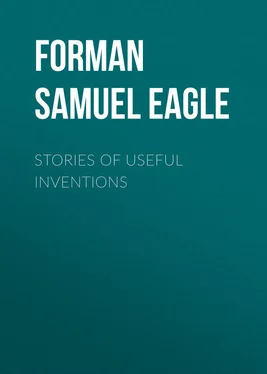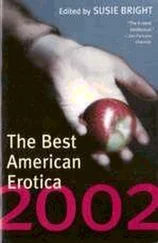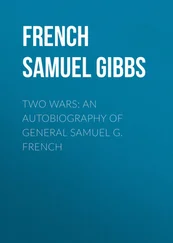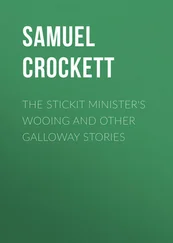Samuel Forman - Stories of Useful Inventions
Здесь есть возможность читать онлайн «Samuel Forman - Stories of Useful Inventions» — ознакомительный отрывок электронной книги совершенно бесплатно, а после прочтения отрывка купить полную версию. В некоторых случаях можно слушать аудио, скачать через торрент в формате fb2 и присутствует краткое содержание. Жанр: foreign_antique, foreign_prose, на английском языке. Описание произведения, (предисловие) а так же отзывы посетителей доступны на портале библиотеки ЛибКат.
- Название:Stories of Useful Inventions
- Автор:
- Жанр:
- Год:неизвестен
- ISBN:нет данных
- Рейтинг книги:5 / 5. Голосов: 1
-
Избранное:Добавить в избранное
- Отзывы:
-
Ваша оценка:
- 100
- 1
- 2
- 3
- 4
- 5
Stories of Useful Inventions: краткое содержание, описание и аннотация
Предлагаем к чтению аннотацию, описание, краткое содержание или предисловие (зависит от того, что написал сам автор книги «Stories of Useful Inventions»). Если вы не нашли необходимую информацию о книге — напишите в комментариях, мы постараемся отыскать её.
Stories of Useful Inventions — читать онлайн ознакомительный отрывок
Ниже представлен текст книги, разбитый по страницам. Система сохранения места последней прочитанной страницы, позволяет с удобством читать онлайн бесплатно книгу «Stories of Useful Inventions», без необходимости каждый раз заново искать на чём Вы остановились. Поставьте закладку, и сможете в любой момент перейти на страницу, на которой закончили чтение.
Интервал:
Закладка:
The other principle is that a mechanical invention is a growth , or, to state the truth in another way, an invention nearly always is simply an improvement upon a previous invention. The loom, for example, was not invented by a particular person at a particular time; it did not spring into existence in a day with all its parts perfected; it grew , century by century, piece by piece. In the stories which will follow the steps in the growth of an invention are shown in the illustrations. These pictures are not for amusement but for study. As you read, examine them carefully and they will teach you quite as much about the growth of the invention as you can be taught by words.
THE MATCH
Did you ever think how great and how many are the blessings of fire? Try to think of a world without fire. Suppose we should wake up some bitter cold morning and find that all the fires in the world were out, and that there was no way of rekindling them; that the art of kindling a fire had been lost. In such a plight we should all soon be shivering with the cold, for our stoves and furnaces could give us no warmth; we should all soon be hungry, for we could not cook our food; we should all soon be idle, for engines could not draw trains, wheels of factories could not turn, and trade and commerce would come to a standstill; at night we would grope in darkness, for we could use neither lamp nor gas nor electric light. It is easy to see that without fire, whether for light or heat, the life of man would be most wretched.
There never was a time when the world was without fire, but there was a time when men did not know how to kindle fire; and after they learned how to kindle one, it was a long, long time before they learned how to kindle one easily. In these days we can kindle a fire without any trouble, because we can easily get a match; but we must remember that the match is one of the most wonderful things in the world, and that it took men thousands of years to learn how to make one. Let us learn the history of this familiar little object, the match.
Fire was first given to man by nature itself. When a forest is set on fire by cinders from a neighboring volcano, or when a tree is set ablaze by a thunderbolt, we may say that nature strikes a match. In the early history of the world, nature had to kindle all the fires, for man by his own effort was unable to produce a spark. The first method, then, of getting fire for use was to light sticks of wood at a flame kindled by nature – by a volcano, perhaps, or by a stroke of lightning. These firebrands (Fig. 1) were carried to the home and used in kindling the fires there. The fire secured in this way was carefully guarded and was kept burning as long as possible. But the flame, however faithfully watched, would sometimes be extinguished. A sudden gust of wind or a sudden shower would put it out. Then a new firebrand would have to be secured, and this often meant a long journey and a deal of trouble.
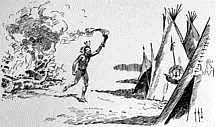
FIG. 1. – GETTING A MATCH FROM NATURE.
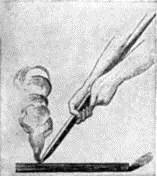
FIG. 2. – PRIMITIVE FIRE-MAKING. THE STICK-AND-GROOVE METHOD.
In the course of time a man somewhere in the world hit upon a plan of kindling a fire without having any fire to begin with; that is to say, he hit upon a plan of producing a fire by artificial means. He knew that by rubbing his hands together very hard and very fast he could make them very warm. By trial he learned that by rubbing two pieces of dry wood together he could make them very warm. Then he asked himself the question: Can a fire be kindled by rubbing two pieces of wood together, if they are rubbed hard enough? He placed upon the ground a piece of perfectly dry wood (Fig. 2) and rubbed this with the end of a stick until a groove was made. In the groove a fine dust of wood – a kind of sawdust – was made by the rubbing. He went on rubbing hard and fast, and, behold, the dust in the groove began to glow! He placed some dry grass upon the embers and blew upon them with his breath, and the grass burst into a flame. 2 2 Mr. Walter Hough of the National Museum, himself a wizard in the art of fire-making, tells me that a blaze cannot be produced simply by rubbing sticks together. All that can be done by rubbing is to make them glow.
Here for the first time a man kindled a fire for himself. He had invented the match, the greatest invention, perhaps, in the history of the world.
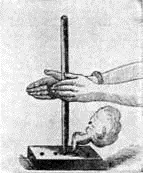
FIG. 3. – THE FIRE DRILL.
(Simple Form.)
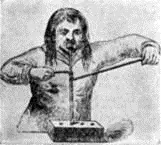
FIG. 4. – FIRE DRILL.
(Improved Form.)
The stick-and-groove method – as we may call it – of getting a flame was much better than guarding fire and carrying it from place to place; yet it was, nevertheless, a very clumsy method. The wood used had to be perfectly dry, and the rubbing required a vast amount of work and patience. Sometimes it would take hours to produce the spark. After a while – and doubtless it was a very long while – it was found that it was better to keep the end of the stick in one spot and twirl it (Fig. 3) than it was to plow to and fro with it. The twirling motion made a hole in which the heat produced by the friction was confined in a small space. At first the drilling was done by twirling the stick between the palms of the hands, but this made the hands too hot for comfort, and the fire-makers learned to do the twirling with a cord or thong 3 3 A narrow strip of leather.
wrapped around the stick (Fig. 4). You see, the upper end of the stick which serves as a drill turns in a cavity in a mouthpiece which the operator holds between his teeth. If you should undertake to use a fire-drill of this kind, it is likely that your jaws would be painfully jarred.
By both the methods described above, the fire was obtained by rubbing or friction . The friction method seems to have been used by all primitive peoples, and it is still in use among savages in various parts of the world.

FIG. 5. – STRIKING FIRE.
The second step in fire-making was taken when it was discovered that a spark can be made by striking together a stone and a piece of iron ore. Strike a piece of flint against a piece of iron ore known as pyrites, or fire-stone, and you will make sparks fly. (Fig. 5.) Let these sparks fall into small pieces of dried moss or powdered charcoal, and the tinder , as the moss or the charcoal is called, will catch fire. It will glow, but it will not blaze. Now hold a dry splinter in the glowing tinder, and fan or blow with the breath and the splinter will burst into a flame. If you will tip your splinter with sulphur before you place it in the burning tinder, you will get a flame at once. This was the strike-a-light, or percussion , method of making a fire. It followed the friction method, and was a great improvement upon it because it took less work and a shorter time to get a blaze. The regular outfit for fire-making with the strike-a-light consisted of a tinder-box, a piece of steel, a piece of flint, and some splinters tipped with sulphur (Fig. 6). The flint and steel were struck together, and the sparks thus made fell into the tinder and made it glow. A splinter was applied as quickly as possible to the tinder, and when a flame was produced the candle which rested in the socket on the tinder-box was lighted. As soon as the splinter was lighted the cover was replaced on the tinder-box, so as to smother the glowing tinder and save it for another time.
Читать дальшеИнтервал:
Закладка:
Похожие книги на «Stories of Useful Inventions»
Представляем Вашему вниманию похожие книги на «Stories of Useful Inventions» списком для выбора. Мы отобрали схожую по названию и смыслу литературу в надежде предоставить читателям больше вариантов отыскать новые, интересные, ещё непрочитанные произведения.
Обсуждение, отзывы о книге «Stories of Useful Inventions» и просто собственные мнения читателей. Оставьте ваши комментарии, напишите, что Вы думаете о произведении, его смысле или главных героях. Укажите что конкретно понравилось, а что нет, и почему Вы так считаете.
